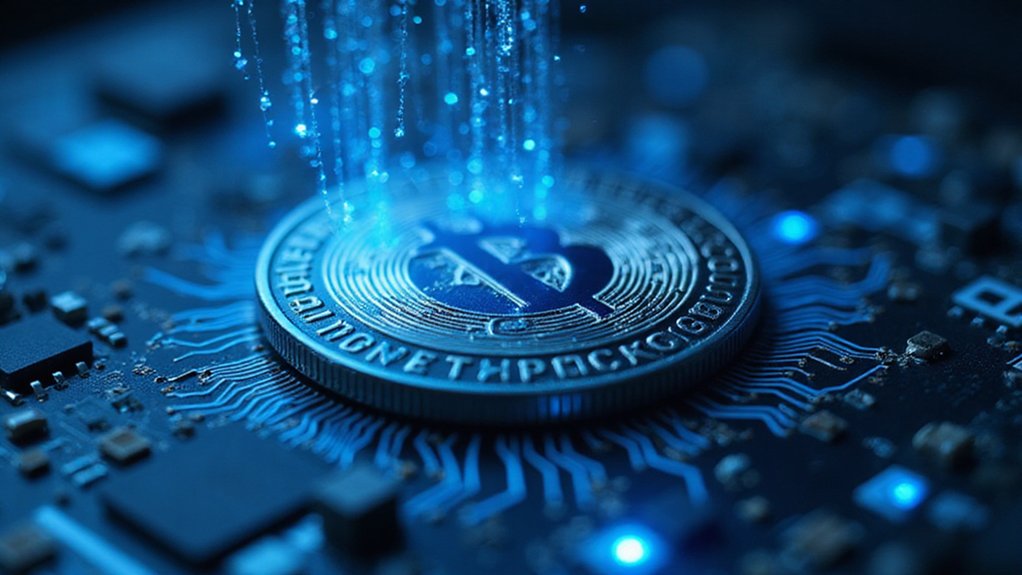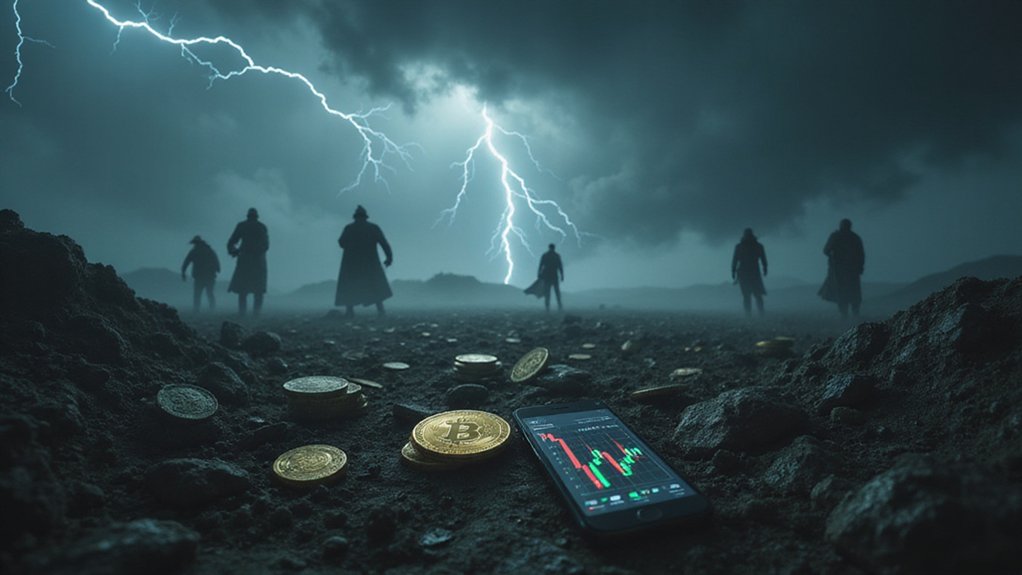Cryptocurrency’s trajectory points toward mainstream financial integration, with the global market projected to reach $5 billion by 2030. Institutional adoption, AI token proliferation, and stablecoin efficiency ($8 trillion annual processing) signal legitimacy beyond speculative investment. Technological innovations—Layer-2 solutions, eco-friendly protocols, and tokenization of illiquid assets—address scalability, environmental concerns, and liquidity challenges. As settlement times shrink from days to milliseconds, traditional finance increasingly yields to blockchain’s irrefutable advantages. The financial revolution has barely begun its opening act.

Where might the landscape of digital finance lead us as traditional financial systems increasingly yield ground to blockchain-based alternatives?
The trajectory appears unmistakable—with the global cryptocurrency market poised to more than double from $2.1 billion to $5 billion by 2030, we’re witnessing not merely a passing technological fancy but a fundamental recalibration of financial infrastructure.
The inexorable digital finance revolution isn’t approaching—it’s already dismantling centuries of banking orthodoxy before our eyes.
Institutional players (those once-staunch skeptics who dismissed crypto as elaborate digital Ponzi schemes) now scramble to establish positions in Bitcoin and its algorithmic progeny.
The maturation of blockchain integration into banking suggests a future where settlement times collapse from days to milliseconds.
Tokenized deposits—banking’s rather belated answer to blockchain innovation—aim to marry traditional financial guardrails with distributed ledger efficiency.
Meanwhile, stablecoins have quietly revolutionized value transfer, processing an astonishing $8 trillion annually while providing financial services to populations traditional banks have long ignored with impressive indifference.
Perhaps most intriguing is the increasingly symbiotic relationship between artificial intelligence and blockchain technology.
The meteoric rise of AI tokens—from $2.7 billion to $39 billion in a single year—demonstrates how quickly these technological domains are converging to create entirely new market paradigms and governance structures.
Layer-2 solutions like Lightning Network continue addressing what skeptics once deemed fatal flaws, tackling scalability issues while reducing prohibitive transaction costs.
Environmental considerations, once crypto’s most vulnerable flank, increasingly find answers in eco-friendly protocols like Cardano and Solana.
Simultaneously, tokenization extends cryptocurrency’s fundamental innovation—distributed, immutable ledgers—to previously illiquid assets, fractionalizing everything from Manhattan penthouses to Picassos.
The cryptographic security that underpins these digital currencies provides robust transaction verification while eliminating the need for intermediaries in the financial ecosystem.
The rise of digital payments has been dramatically accelerated by the COVID-19 pandemic, creating an environment where contactless payment solutions are increasingly normalized and expected.
The regulatory landscape, while still evolving with the characteristic speed of government bureaucracy¹, shows signs of providing the clarity institutional investors require for fuller participation.
As wholesale CBDCs gain traction over their retail counterparts, central banks appear to be conceding that blockchain’s advantages for interbank settlement are simply too compelling to ignore.
The question now seems less whether cryptocurrency will transform finance, but rather how completely traditional systems will be subsumed by its methodologies.
Bitcoin’s remarkable resilience through economic turbulence has been demonstrated by its price stabilization in 2025 Q2 following significant volatility caused by US trade tariffs.
¹Which is to say, glacially.
Frequently Asked Questions
How Does Cryptocurrency Mining Impact the Environment?
Cryptocurrency mining—particularly Bitcoin’s energy-hungry proof-of-work method—exacts a staggering environmental toll, consuming electricity on par with small nations while generating substantial carbon emissions (predominantly from coal-based sources).
This digital gold rush produces a cascade of consequences: significant e-waste from rapidly obsolete ASICs, increased air pollution, and water contamination from cooling systems.
The industry’s halting pivot toward renewable energy and more efficient protocols remains insufficient to offset its outsized ecological footprint.
Can Cryptocurrencies Be Regulated Without Losing Their Decentralized Nature?
Cryptocurrencies can indeed be regulated without sacrificing decentralization, though the balance remains precarious.
Regulatory approaches targeting service providers rather than protocols themselves—as exemplified by portions of the EU’s MiCA framework—offer promising pathways.
The distinction between truly decentralized projects and those merely claiming the label proves vital; sensible frameworks can protect consumers while preserving the cryptographic privacy and distributed validation that constitute cryptocurrency’s raison d’être.
What Security Measures Protect Cryptocurrency From Hackers?
Cryptocurrency security hinges on layered defenses: hardware wallets isolate private keys offline, while cold storage guarantees complete air-gapping from potential remote attacks.
Two-factor authentication (preferably hardware-based, as SMS remains vulnerably quaint) supplements robust authentication protocols.
Multisignature arrangements require multiple approvals—remarkably effective against singular points of failure.
Between vigilance against phishing schemes and adherence to established crypto security standards, users can navigate the digital asset landscape with reasonable—though never absolute—security.
How Do Cryptocurrency Transaction Fees Compare to Traditional Banking?
Cryptocurrency transaction fees typically undercut traditional banking fees substantially—particularly for international transfers, where banks might charge upwards of $45 compared to crypto’s single-digit fees.
While blockchain networks experience variable costs during congestion periods (Bitcoin’s fees can spike during high-volume trading), they maintain an edge by eliminating intermediaries.
Banks compound expenses with exchange rate markups and service charges, whereas cryptocurrencies offer fee flexibility and transparency in a decentralized ecosystem.
Will Cryptocurrencies Eventually Replace Physical Cash Completely?
While cryptocurrencies continue to gain traction, complete replacement of physical cash remains improbable. Cash persists as essential for underbanked populations, privacy-conscious transactions, and during technological failures.
The future likely entails a hybrid ecosystem where crypto coexists alongside CBDCs and traditional cash—each serving distinct needs.
Even as digital payments dominance grows (particularly through stablecoins and potential CBDCs), cash’s inherent anonymity and universal accessibility maintain its relevance in global commerce.









